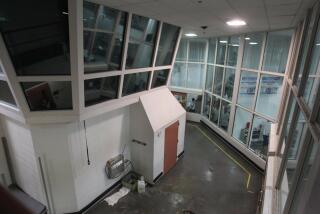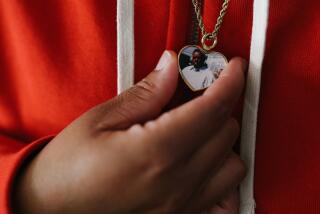The man in the leg irons and mask
- Share via
PHOENIX — His legs shackled and his wrists in handcuffs, Robert Daniels craned his neck past the armed Maricopa County sheriff’s deputy and gazed at a sliver of daylight spilling through the hospital doors.
“That’s the first time I’ve seen sunlight in ... “ Daniels’ voice trailed off. He couldn’t remember the last time.
The 27-year-old has been confined to a sealed room in the Maricopa County Medical Center’s jail ward since August. He has not committed a crime but is under lockdown by health authorities because he suffers from a drug-resistant form of tuberculosis, yet went out in public without a face mask. He also failed to take required medications.
“It’s not fair that they put me in jail,” Daniels said during a recent hospital room interview. A thick breathing mask covered his mouth and nose.
He said being locked up alone for nine months in a room that is lighted 24 hours a day had brought him to the brink of madness. “You can’t imagine what it’s like,” he said.
County officials say that they must forcibly quarantine a tuberculosis patient nearly every year and that the only secure facility in the state is the fourth-floor jail ward of the county hospital.
There, two rooms are sealed with a reverse air flow. The contaminated air is sucked through a pipe and released outside, above the building. Dr. Bob England, director of the Maricopa County Department of Public Health, said diluting the contaminants into the open air effectively removes the risk of infecting others.
A TB patient can step outside without a mask and not put anyone in danger, England said. The concern is that a patient who doesn’t wear a mask will go into an indoor public space.
“For us, it’s all about keeping the germs away from other people,” England said. “When it’s someone who’s demonstrated they can’t do that voluntarily, they need to be in a setting that’s secure.”
Health officials here say they believe agencies elsewhere in the country also put forcibly isolated patients in jail, but they were not able to provide examples. In Los Angeles County, such patients usually are confined to their homes or isolation wards in county hospitals, said Dr. Jonathan Fielding, the county’s public health director.
Daniels said he was willing to stay in isolation and wanted to continue his treatment.
However, he wants to be housed in a hospital room outside the jail ward. After he went public with his complaints last month, the American Civil Liberties Union of Arizona joined Daniels’ case and has said it would file a motion to compel his release.
“The conditions he’s in are a lot worse than that of the average inmate,” ACLU attorney Dan Pochoda said at a hearing last week.
Daniels, a U.S. citizen born in the Soviet Union, was raised in Scottsdale, Ariz., and returned to Russia 10 years ago. He says he does not know how he contracted tuberculosis, a bacterial illness that usually attacks the lungs and can be fatal if left untreated. When Daniels began coughing up blood last year, he bought a plane ticket to Phoenix, hoping to get better medical care.
Daniels lived out of a used car for weeks, working odd jobs. His disease worsened, and he was rushed to an emergency room and then placed in a county-run facility for quarantined homeless TB patients.
He didn’t think much of the requirement that he wear a mask when he left his apartment. “I thought that was overreacting,” he said.
“Where I come from, Russia, no one wears a mask, not even doctors.”
Daniels also admitted that he hadn’t followed his heavy regimen of pills, but only because he sometimes overslept.
The doctors at the facility flagged Daniels as a problem, and in August they asked a judge to order that he be forcibly isolated. The county placed him in the jail ward at the hospital.
“This patient, in my opinion, needs to be in secure isolation,” said Dr. Maricela Moffitt, “because he can’t be trusted to remain in isolation on his own.”
Sitting in a featureless white room with frosted glass windows and a small pane in the door leading to the hall, Daniels said, “At first I was happy [to be in a hospital], because I was so sick I was about to die.
“Then I started thinking: officer outside the window, no shower. I figured out I was in jail.”
He had some comforts, like hospital food rather than jail food, and his own television. A nurse got him a computer, but sheriff’s officials confiscated it -- then took his TV and pay phone as well.
After the Arizona Republic wrote about his case last month, he got the TV back and was allowed to have a cellphone.
Daniels’ condition is improving. And while he is happy for the medical treatment, he feels he’s been punished excessively for disobeying orders once. “I learned my lesson,” he said.
But Moffitt, testifying last week, said Daniels was still a public threat -- even more so now that his health is improving.
“If somebody’s noncompliant when he is actively dying from this disease,” she said, “it is much easier to [break quarantine] when he feels good.”
Times researcher Lynn Marshall in Seattle contributed to this report.
More to Read
Sign up for Essential California
The most important California stories and recommendations in your inbox every morning.
You may occasionally receive promotional content from the Los Angeles Times.










